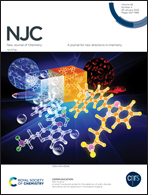High proton conductivity in a charge carrier-induced Ni(ii) metal–organic framework†
Abstract
Fuel cell technology for hydrogen production demands membrane materials with high proton conductivity at relatively high temperatures. Thus, optimization of the proton conductivity of membrane materials is very demanding and is largely dependent on the stable structure of water molecules, which act as a carrier for the proton transport. Usually, this water structure starts to decompose at elevated temperatures. Herein, we have synthesized a new crystalline nickel-based metal–organic framework (MOF) material, H8L-Ni-MOF, having nanopores of ca. 1.5–2.6 nm under hydrothermal reaction conditions. After treating the H8L-Ni-MOF material with 1.5 M sulfuric acid, it yields a proton-conducting framework material H+@H8L-Ni-MOF. The acid-doped Ni-MOF exhibits an outstanding proton conductivity of 1.17 × 10−2 S cm−1 at 90 °C and 98% relative humidity, which is much higher than that of the corresponding as-synthesized MOF. Further, we employed the Grotthuss mechanism to investigate the proton conduction ability of H+@H8L-Ni-MOF through its nanoporous channel at a low activation energy in comparison with other proton-conducting MOFs and found that this novel Ni-MOF has greater potential to be explored in fuel cell applications.



 Please wait while we load your content...
Please wait while we load your content...